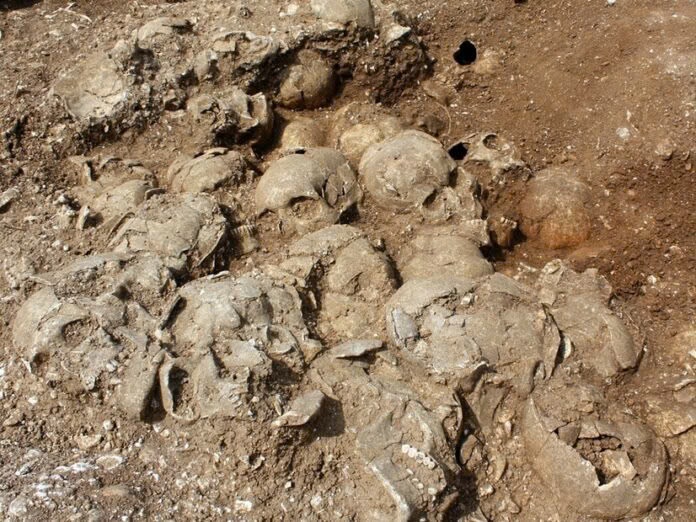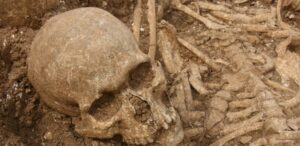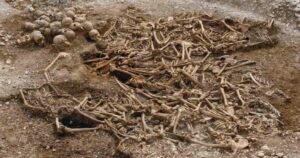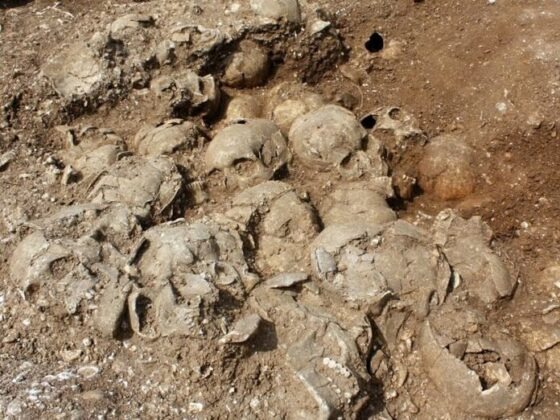A striking archaeological discovery near Weymouth, Dorset, has offered a rare glimpse into the violent clashes between Anglo-Saxons and Viking raiders during the early medieval period. Unearthed in 2009 ahead of a road construction project, a mass grave containing 51 decapitated young men — likely of Scandinavian origin — has become one of the most significant Viking-age finds in Britain.
The burial provides a sobering look at the realities of conflict in the early 11th century and raises important questions about warfare, identity, and ritual practice during this turbulent era.
Discovery of the Mass Grave

The grave was uncovered by Oxford Archaeology during preliminary excavations for the Weymouth Relief Road. Inside a disused Roman quarry pit, archaeologists found the skeletons of dozens of men lying in neat rows. Their skulls had been deliberately placed in a separate pile, suggesting a coordinated execution rather than a chaotic battlefield burial.
Radiocarbon dating later placed the event between AD 970 and 1025, aligning with the height of Viking raids and political instability across Anglo-Saxon England.
Who Were These Men?
Osteological analysis revealed that the individuals were mostly young adults, many displaying evidence of muscular, physically active lifestyles — consistent with warriors or maritime raiders. Isotope testing on their teeth indicated Scandinavian origins, supporting the theory that these were Vikings captured and executed on English soil.
The lack of clothing, weapons, or personal items suggests they were stripped before being killed, likely as prisoners.
Interpreting the Execution

The condition of the remains indicates a controlled, systematic beheading rather than combat trauma. Cut marks on the vertebrae show that some individuals were decapitated from behind, while others bear evidence of repeated strikes — suggesting the executioners may have lacked experience or faced resistance.
This discovery aligns with historical accounts from the late 10th and early 11th centuries:
-
Viking raids were increasing in southern England.
-
Anglo-Saxon rulers, including King Æthelred II, issued orders to eliminate Viking groups caught on English territory.
-
Tensions between local populations and Scandinavian raiders were escalating.
The Weymouth grave may reflect one such retaliatory act.
Cultural Meaning of Beheading in Viking and Anglo-Saxon Contexts

While execution by beheading was practiced in various medieval societies, the deliberate placement of skulls apart from the bodies suggests a symbolic message. Some researchers propose:
-
A demonstration of Anglo-Saxon authority, intended to intimidate future invaders.
-
A ritual effort to prevent the executed from entering the afterlife, given Viking beliefs surrounding an intact body.
-
A practical method of burial, ensuring the pit could accommodate many individuals.
Although definitive interpretations remain debated, the treatment of the bodies clearly reflects deliberate choices rather than improvised burial under battlefield conditions.
Broader Historical Context

The find sheds light on a period when England was repeatedly targeted by Scandinavian raiders and armies. These decades saw:
-
Danish incursions along the southern coast
-
The payment of Danegeld (tribute) to deter raids
-
Political turmoil leading up to the Danish conquest of England under Cnut
The Weymouth burial adds archaeological weight to written accounts describing episodes of mass retaliation and escalating violence during this era.
Why the Site Matters
Beyond its dramatic appearance, the mass grave is important for several reasons:
-
It provides rare physical evidence of how captured Viking fighters may have been treated.
-
It helps refine our understanding of Anglo-Saxon military responses to raiders.
-
It offers insight into the movement and origins of Viking groups through isotopic analysis.
-
It reveals the overlap of Roman, Anglo-Saxon, and Scandinavian histories at a single site.
As research continues, specialists hope to uncover more about the individuals’ origins, whether they belonged to a unified raiding party, and the political circumstances that led to their execution.
Conclusion
The excavation near Weymouth stands as one of the most evocative archaeological discoveries linked to Viking activity in Britain. The remains of the 51 young men — stripped, decapitated, and carefully arranged — illustrate the harsh realities of warfare and justice in the early 11th century.
Far from a simple story of invaders and defenders, the burial highlights a complex web of cultural interaction, conflict, and ritual practice. It deepens our understanding of the Viking presence in Britain and continues to encourage historians and archaeologists to re-examine long-held assumptions about this transformative period.
As new analyses emerge, the Weymouth warriors will undoubtedly remain central to discussions about identity, violence, and cultural exchange in early medieval Europe.
Sources
-
Oxford Archaeology – “The Ridgeway Viking Burial: Weymouth Relief Road Excavations”
-
BBC News – “Decapitated Vikings Found in Mass Grave in Dorset”
-
National Geographic – “Viking Mass Grave Reveals Execution Rituals”
-
Journal of Archaeological Science – isotopic analysis reports on the Weymouth remains
